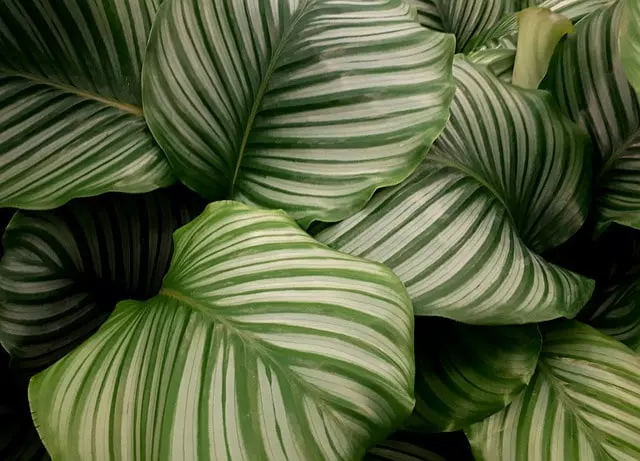A beautiful tropical plant, Calathea is often nicknamed in some areas as the “peacock plant” because of the often-oblong shape of its leaves, which are decorated with a contrasting feather-like pattern. In addition, they close at night to reopen harmoniously every morning. Learn how to propagate and care Calathea in this article.
The Calathea belongs to the Marantaceae family. Native to the tropical rainforests of South America (mainly Brazil), it is called by its Latin name Calathea or, without the ‘h’ calatea.
Its remarkable evergreen foliage varies in size between 6” and 24” (15 and 60 cm), and in shape (rounded, lanceolate, elongated), as well as in its shades of color (more or less dark green, spotted or mottled).
The leaves have the characteristic of being arranged perpendicular to the stems. Flowering is somewhat common and discreet, hidden in the bracts (the flowers themselves are small, usually white or yellow), except for Calathea crocata which has beautiful bright orange flowers.
It is a perennial plant used in pots, indoors, greenhouses, and miniature gardens.
It cannot be grown outdoors in our regions because it is very sensitive to cold.
Calathea requires patience (its growth is rather slow) and particular growing conditions due to its origins. If care is taken to provide it with humidity, water, warmth, and to avoid drafts and temperature differences, it can be kept for many years.
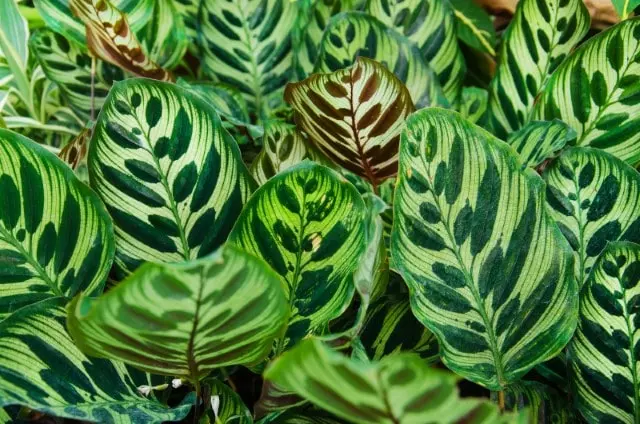
Table of Contents
How to Propagate Calathea Step by Step
Calathea can be propagated easily by division in late spring and throughout the summer.
Follow these steps to propagate Calathea by division:
- Choose strong rhizomes.
- Divide the rhizomes using a clean knife and make sure the entire division retains its roots and some leaves.
- Untangle the roots and shred the compost.
- Plant each division in 3” (8 cm) diameter pots, filled with a normal moist substrate.
- Cover the pots with clear plastic bags and place them in a light-free area at a temperature of 60 to 64 °F (16 to 18 °C) for at least a week.
- Be sure to maintain a very humid environment, this is essential so that the plants do not dry out.
- Wait until new roots form, then remove the plastic bags.
- From now on, you take care of them as adult plants.
This is the only way to propagate Calathea, do not believe in other methods such as cuttings or seeds.
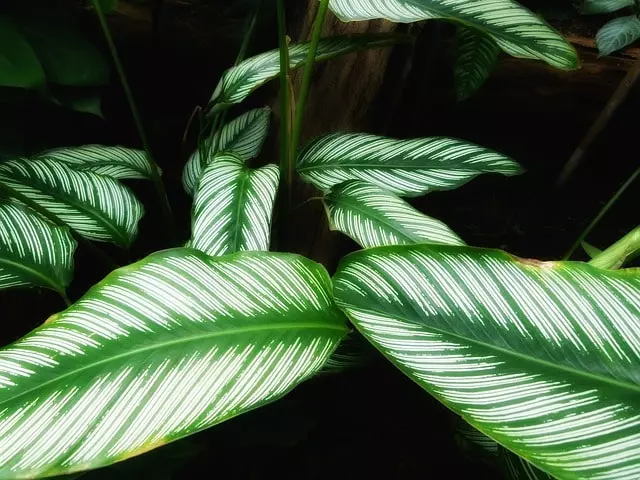
How to Care Calathea
You already know how to propagate a Calathea plant correctly, now for this plant to grow healthy and strong follow all the care tips for Calathea. Also in the following paragraphs, you will learn the best time to propagate Calathea as this is very important for successful propagation.
Where to Plant Calathea?
Calathea is a tropical perennial plant that requires special attention to hygrometry and temperature: humidity and heat without excess are essential, otherwise the air becomes too dry. The warm greenhouse is ideal. In a classic room, you can place a humidifier nearby.
It needs well-drained soil rich in humus. The ideal is to prepare a mixture of:
- 1/3 peat or chopped leaves. (Order here).
- 1/3 of sterilized fibrous soil. (Order here).
- 1/3 coarse sand or fine perlite. (Order here).
Another option is to use a commercial mix with ready-made peat.
Calathea likes a dim light; a north-facing window (in the north H.H.) will be fine.
Never place it in too bright a light or in direct sun as it will burn its foliage.
The ideal room temperature for it is between 60 and 70 °F (16 and 21 °C). In winter, it prefers a place with a temperature between 55 and 60 °F (13 and 16 °C), never below 50 °F (10 °C).
Avoid placing it near radiators and heat sources.
Tip: If your climate is warmer, increase the humidity and water and spray your Calathea daily.
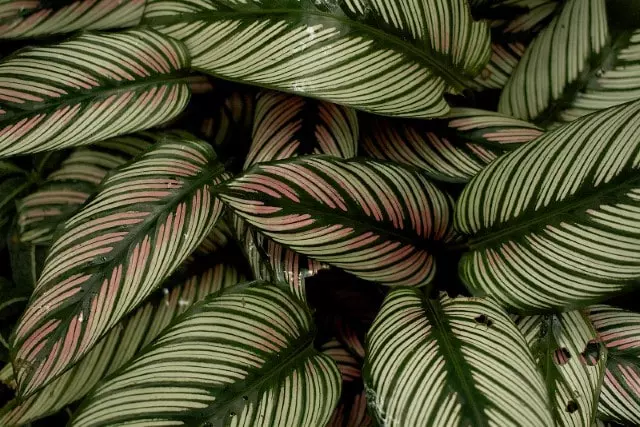
When And How to Propagate Calathea?
It should be planted preferably in March.
Choose a pot about 4” to 6” (10 to 15 cm) in diameter, with holes in the bottom. Plan a larger pot from the beginning for Calathea ornata and Calathea zebrina.
- Add a bed of clay beads to the bottom of the pot, to improve drainage.
- Prepare the appropriate mix and fill part of the pot.
- Place the plant well in the center spreading its roots.
- Fill with the rest of the substrate.
- Tamp and water, making sure to empty the saucer so that the water does not stagnate. This would cause its roots to rot.
- Pin Stripe Prayer Plant - Calathea ornata - Easy House Plant - 4" Pot
- 811332031002
- Easy to grow house plant
- All of our listings have very representative pictures of what you would receive.
- This plant comes fully rooted in a 6" pot, ready to grow in and your beautiful home or your office.
- Enhance Your Environment
General Care of Calathea
Water the Calathea very well during its growing period, we should always keep the root ball moist. You can surround the pot with sphagnum moss that will maintain good humidity.
During the resting periods, watering should be moderate. At this time, be sure to let the soil dry out 0.4” (1 cm) between waterings.
Tip: preferably use warm, non-calcareous water, such as rainwater, which does not stain the foliage of your plant.
Make a contribution of highly diluted liquid fertilizer for green plants every 15 days, during the vegetative period, from the first month of spring until the beginning of autumn.
Clean the foliage regularly, because its leaves retain dust. Dust it once a week, using a feather duster, passing it from top to bottom and on both sides of the foliage. You should also use a damp sponge if the dust is kind of stuck to it.
Transplant this beauty every year into a larger pot during the first month of summer. This is necessary because Calathea quickly depletes the soil of nutrients.
As for pruning, it is not required. We should only remove the leaves as they fade.
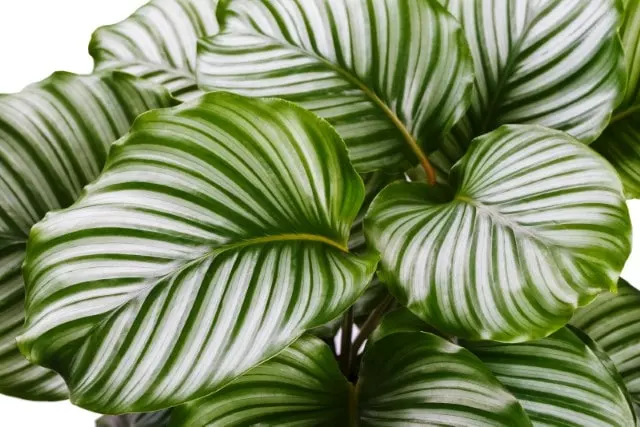
Cathalea Diseases, Pests, and Parasites
Calathea is not usually attacked by pests or diseases. Beware, however, of mealybugs that make the leaves sticky and red spider mites that can weave on the underside of the leaves, causing them to turn yellow.
To remedy this, it is necessary to increase the ambient humidity and spray an acaricide if the damage is too significant.
If your environment is not humid enough, the Calathea may dry out or turn brownish, curling up its leaves.
It may help to humidify the air (you should use a humidifier), place the plant on a bed of wet pebbles or clay balls, and spray its foliage.
If Calathea gets too much light or if it lacks nitrogen, its leaves will wilt and fall off. Avoid direct sun or too much light and apply a nitrogen fertilizer regularly.
